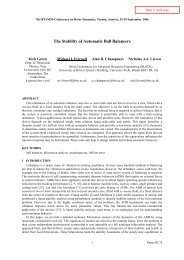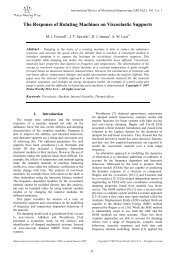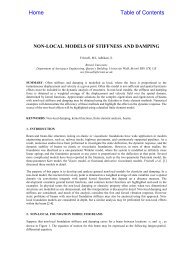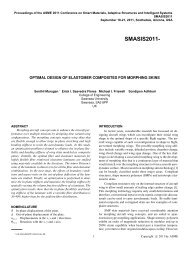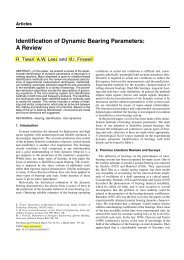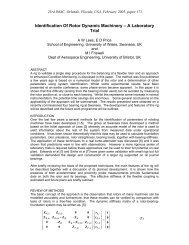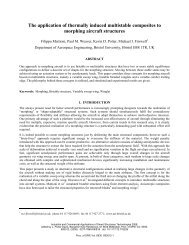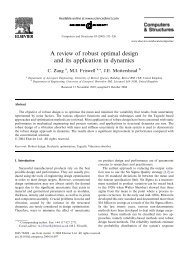The Dynamics of Rotating Machines with Cracks ... - Michael I Friswell
The Dynamics of Rotating Machines with Cracks ... - Michael I Friswell
The Dynamics of Rotating Machines with Cracks ... - Michael I Friswell
Create successful ePaper yourself
Turn your PDF publications into a flip-book with our unique Google optimized e-Paper software.
314<br />
Modern Practice in Stress and Vibration Analysis<br />
4 Title <strong>of</strong> Publication (to be inserted by the publisher)<br />
4. A Jeffcott rotor example<br />
A Jeffcott rotor modelled using two degrees <strong>of</strong> freedom will be used to demonstrate the effect <strong>of</strong> the<br />
different assumptions in the equations <strong>of</strong> motion <strong>of</strong> the cracked rotor. <strong>The</strong> rotor is 700 mm long,<br />
<strong>with</strong> a diameter <strong>of</strong> 15 mm, and has a 1 kg disc at the centre. <strong>The</strong> crack is assumed to be located<br />
close to the disc and only responses that are symmetrical about the shaft centre are considered. <strong>The</strong><br />
natural frequency <strong>of</strong> the rotor is approximately 42 Hz the damping ratio is taken as 1%. Gyroscopic<br />
effects are neglected. An unbalance force arising from a 10 g mass at 100 mm radius is used to<br />
excite the rotor, and at t = 0 the crack is closed and the unbalance force is in the x direction.<br />
To consider the effect <strong>of</strong> weight dominance consider a crack <strong>of</strong> 40% <strong>of</strong> the diameter, modelled<br />
using the Mayes approach <strong>with</strong> stiffness reduction for the fully open crack <strong>of</strong> 9% and 4% in<br />
directions perpendicular and tangential to the crack front. <strong>The</strong>se reductions in direct stiffness due to<br />
the open crack are taken directly from the results <strong>of</strong> the model <strong>of</strong> Jun et al. [5]. A rotor speed <strong>of</strong><br />
1240 rev/min is simulated, which is just below half <strong>of</strong> the machine’s natural frequency. <strong>The</strong> static<br />
deflection <strong>of</strong> the undamaged rotor is 0.14 mm. <strong>The</strong> time simulations are run until the transient<br />
motion becomes negligible and the steady state solution remains. Figure 1 compares the orbit <strong>of</strong> the<br />
full solution <strong>of</strong> the equations <strong>of</strong> motion (solid) and the weight dominated solution (dotted) when<br />
there is no unbalance force. Clearly the assumption <strong>of</strong> weight dominance is a good one. When the<br />
4<br />
unbalance increases to 10 kg m the assumption <strong>of</strong> weight dominance is not so good, and there is<br />
clearly some difference in the phase when the crack opens and closes (Figure 2). By the time the<br />
3<br />
unbalance has increase to 10 kg m there is a qualitative difference in the weight dominated<br />
solution, which still shows a significant 2X response, and the full solution which shows<br />
4<br />
predominantly a 1X response (Figure 3). Note that <strong>with</strong> unbalance <strong>of</strong> 10 kg m the vertical<br />
displacement never becomes positive, that is the response from the unbalance is always a smaller<br />
3<br />
magnitude than the static deflection due to gravity. This is not so for an unbalance <strong>of</strong> 10 kg m.<br />
0.0<br />
0.0<br />
-0.1<br />
-0.1<br />
-0.2<br />
-0.2<br />
-0.3<br />
-0.1 0 0.1<br />
Figure 1. Comparison <strong>of</strong> the rotor orbit <strong>with</strong><br />
no unbalance. Full equations (solid), weight<br />
dominance assumption (dotted). All<br />
dimensions in mm.<br />
-0.3<br />
-0.1 0 0.1<br />
Figure 2. Comparison <strong>of</strong> the rotor orbit <strong>with</strong><br />
4<br />
an unbalance <strong>of</strong> 10 kg m. Full equations<br />
(solid), weight dominance assumption<br />
(dotted). All dimensions in mm.




